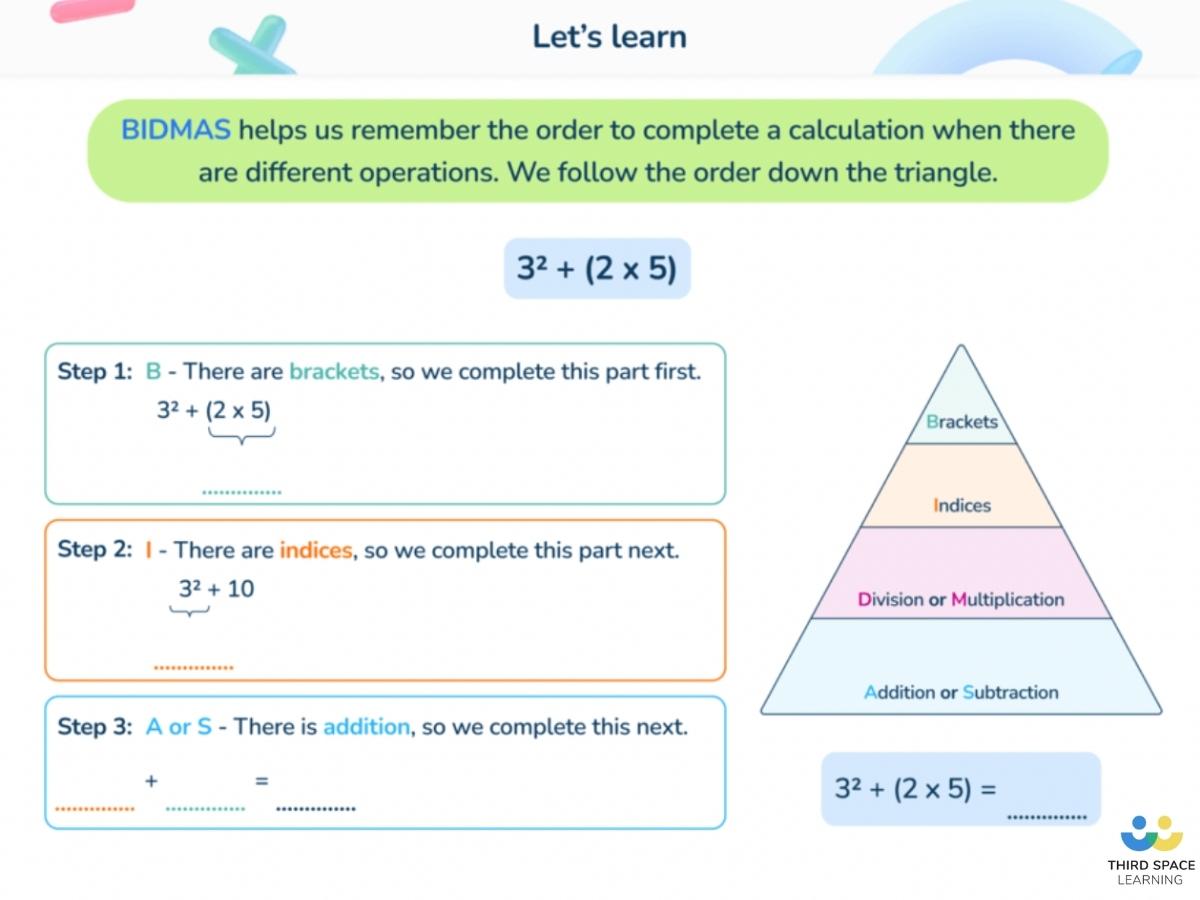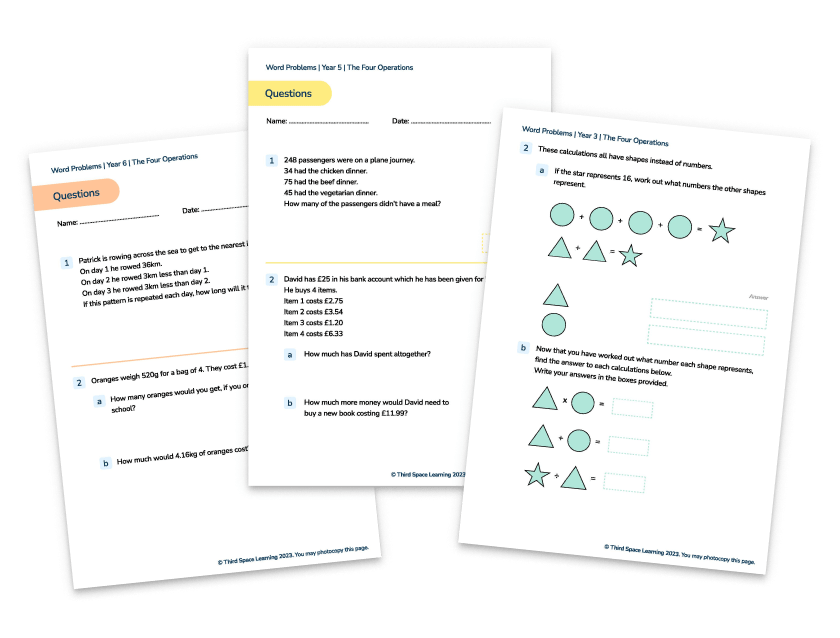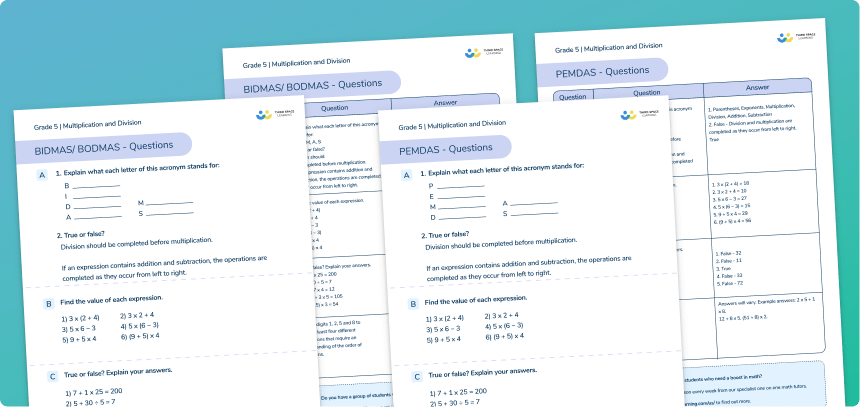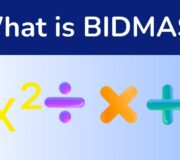What is PEMDAS? Explained For Kids, Parents & Teachers
PEMDAS pops up throughout primary and secondary school and is a popular acronym used to help students remember the order of operations. In this article, we explain what PEMDAS means, provide worked examples and practice questions to support your students in the classroom.
Year 6 PEMDAS Questions Worksheet
Download this free worksheet to help your maths class practise their understanding of Pemdas, Bodmas, and Order of operations
Download Free Now!What is PEMDAS?
PEMDAS is a well-known acronym used to help students remember the order of operations.
PEMDAS stands for:
- Parentheses, also known as brackets
- Exponents
- Multiplication
- Division
- Addition
- Subtraction
What is the PEMDAS rule?
The PEMDAS rule tells students how to solve maths problems with multiple operations and in which order they should be completed in order to produce the correct answer.
It is important to note that the inverse operations multiplication and division, as well as addition and subtraction, are interchangeable within this list, and are performed from left to right as they appear within an expression.
To avoid confusion, some teachers prefer to display PEMDAS as shown below, with M/D (for multiplication and division) and A/S (for addition and subtraction) at the same level:
| P | Parentheses: ( ) [ ] { } |
| E | Exponents: 22 43 |
| M/D | Multiplication and Division: x ÷ from left to right |
| A/S | Addition and Subtraction: + –from left to right |

Unlimited primary maths tutoring with Skye, the voice-based AI maths tutor.
Built on the same principles, pedagogy and curriculum as our traditional tutoring, but with more flexibility, reach and lower cost.
Join the schools already helping hundreds of primary pupils nationwide with Skye’s one to one maths tutoring.
Watch Skye in actionWhat’s the difference between PEMDAS, BODMAS and BIDMAS?
PEMDAS, BODMAS, and BIDMAS are all acronyms that serve the same purpose – to help students remember the order of operations when solving mathematical equations with multiple operations. These acronyms differ based on where they are used.
For example, PEMDAS is commonly used by mathematicians in the US, while BODMAS and BIDMAS are commonly used in the UK. Canada and New Zealand often use BEDMAS. The highlighted terms in the table below show where they differ.
Note that the terms parentheses and brackets, as well as the terms exponents, orders, and indices are referring to the same concepts.
| PEMDAS | BODMAS | BIDMAS |
| Parentheses Exponents Multiplication Division Addition Subtraction | Brackets Orders Division Multiplication Addition Subtraction | Brackets Indices Division Multiplication Addition Subtraction |

Why is PEMDAS important?
PEMDAS is important because the order of operations is important! The order of operations is a set of rules for solving maths equations and expressions with multiple operations. This set of rules ensures that all maths equations are solved in the same way. If equations are solved simply in the order they appear, you may end up with the wrong answer.
Students are able to refer to the rules of PEMDAS to solve equations or evaluate expressions in a correct and consistent step by step process. PEMDAS is important because it provides a way for students to remember this set of rules in the correct order.
How do you remember PEMDAS?
PEMDAS may be memorable for many but some learners may prefer a mnemonic device to help them remember to easily recall each letter of PEMDAS. The most common is Please Excuse My Dear Aunt Sally.
Some teachers challenge their students to come up with their own mnemonic device for PEMDAS, which may motivate the students to remember the acronym more easily. Students can come up with silly mnemonics, such as Purple Elephants March Down A Street.
When do children learn about PEMDAS in school?
PEMDAS and the order of operations is most commonly taught in Year 6 and Year 7.
This sets a strong foundation for students to learn more complex mathematical concepts involving algebraic expressions throughout secondary school. These more complex equations and expressions may involve square roots, decimals, variables, integers, etc. but the rules of PEMDAS and the order of arithmetic operations will remain consistent.
PEMDAS in Year 6
PEMDAS and the order of operations first appear in Year 6. Students must be able to evaluate expressions that involve parentheses ( ), brackets [ ], or braces { } and they must understand how to determine in which order they should evaluate each part of the expression. Students may be tempted to move through the expression from left to right, but PEMDAS will help them remember not to do this.
Students also need to be able to represent mathematical expressions in written form. The wording they use should convey the order in which the parts of the expression should be evaluated.
For example, we may describe the expression 3 x (5 + 2) as “three times the sum of five and two.” If we described it as “three times five plus two,” this would not convey the fact that the addition (which is within the parentheses) needs to be performed before the multiplication.
PEMDAS in Year 7
PEMDAS in Year 7 appears under the domain of Expressions & Equations. Students’ understanding of the order of operations is extended as they work with more complex numerical expressions involving variables, which is a letter used as an unknown number in an expression (i.e., 4 + x = 7).
Students need to have a strong understanding of the order of operations as they move into this more complex content. Students and teachers will use PEMDAS while tackling these higher-level standards to support their knowledge of the order of operations.
PEMDAS worked examples
PEMDAS worked examples for Year 6
Question 1: 6 x 4 + 8 ÷ 2
Step 1: In this example, we see the operations multiplication, addition, and division, in that order. According to PEMDAS, we need to perform any multiplication or division, from left to right as they appear, before any addition or subtraction.
After performing the multiplication, we are left with 24 + 8 ÷ 2
Step 2: Now that we have addition and division left, we perform the division first.
After dividing, we are left with 24 + 4
Answer: 24 + 4 = 28
Question 2: (8 + 5) – 3 x 22
Step 1: In this example, we see the operations addition, subtraction, and multiplication, in that order, but we also have a set of parentheses and an exponent. Following PEMDAS, we need to perform anything within parentheses first, then calculate exponents before moving onto the operations.
After calculating inside the parentheses, we are left with 13 – 3 x 22
Step 2: Now, we move onto the exponent.
After calculating the value of the exponent, we are left with 13 – 3 x 4
Step 3: We have multiplication and subtraction remaining in our expression, so we need to perform the multiplication before the subtraction. Here is where you will most often find students making a mistake. They will want to perform the subtraction first (13 – 3 = 10) and then the multiplication (10 x 4 = 40) but that would give them an incorrect answer of 40.
After performing the multiplication first, we are left with 13 – 12.
Answer: 13 – 12 = 1
Question 3: 5 x [3 + (32 – 8)]
Oftentimes, as Year 6 students become more proficient with this content, they will encounter more complex expressions involving more grouping symbols. Instead of just parentheses, they may also see brackets [ ] and braces { }. These should always be performed starting with the innermost grouping symbol, which should be parentheses.
Step 1: We shift our attention to the innermost grouping symbol, the parentheses. Inside the parentheses, we see an exponent as well as subtraction. We need to calculate the value of the exponent first.
After calculating the value of the exponent, we are left with 5 x [3 + (9 – 8)]
Step 2: Now that we have calculated the exponent, we perform the operation within the parentheses, which is subtraction.
After subtracting, we are left with 5 x [3 + 1]
(Notice I have removed the parentheses, since all that was left inside them was a single number.)
Step 3: Now that we have calculated the inside of the parentheses, we move onto the next grouping symbol, which is the brackets. We treat these the same as parentheses, so we need to perform the addition inside them before we can perform the multiplication within our expression.
After performing the addition in the brackets, we are left with 5 x 4
Answer: 5 x 4 = 20
PEMDAS worked examples for Year 7
In Year 7, students use the same concept of PEMDAS and the order of operations, but they have an added layer of complexity as they are introduced to variables, which are letters used in place of unknown numbers.
Question 1: 6 x y2 if y = 3
Step 1: The first thing we need to do to find the value of this expression is replace our variable with its value. In this example, we are given the value of our variable y, which is 3.
Once we replace our variable, we are left with 6 x 32
Step 2: Next, we follow the PEMDAS rule of calculating exponents before any operations.
Once we evaluate our exponent, we are left with 6 x 9
Answer: 6 x 9 = 54
Question 2: 3n + 8 x (4y – 3) if n = 2 and y = 1
In Year 7, students are also introduced to a new way to read and write multiplication. As they learn about variables, they also learn that a term such as 3n represents multiplication. The 3 and the variable next to it are meant to be multiplied. Similarly, if students see a number next to a parenthesis, for example 2(4), this also represents multiplication, so this example would equal 8.
Step 1: First, we need to input the values of our variables.
Since n = 2 and y = 1, our expression becomes 3(2) + 8 x (4 x 1 – 3)
Step 2: Now, let’s work within our grouping symbols. The term 4y became 4 x 1, which we know is 4. So we are left with 4 – 3 within our parentheses, which is 1.
3(2) + 8 x (1)
Step 3: Now we are left with multiplication, addition, and multiplication in that order. If there are parentheses left around a single number (1 in this example), it has no significance unless it is directly next to another number, as we see 3(2). As mentioned above, this signifies multiplication.
Let’s perform the multiplication that comes first from left to right to keep in line with our PEMDAS rule.
We are left with 6 + 8 x (1)
Step 4: Now that we have addition and multiplication remaining, we can perform the other multiplication piece.
We are left with 6 + 8
Answer: 6 + 8 = 14
PEMDAS practice questions
Below, we have included PEMDAS questions suitable for Year 6 and Year 7 students, including answers.
PEMDAS questions for Year 6:
7 + 3 x 4 ÷ 2
Answer: 13
8 x (12 – 9) + 4 ÷ 2
Answer: 26
6 x 32 + (7 – 4)
Answer: 57
9 x [18 – (2 x 3)] ÷ 4
Answer: 27
53 – [3 x (1 + 2)]2
Answer: 44
PEMDAS questions for Year 7:
5x – 42 if x = 8
Answer: 24
4(9 – 22) x 3y if y = 4
Answer: 240
Which exponent makes the equation true?
(9 – 6)3 + _______ = 43
Answer: 42
Which number makes the inequality true?
7 + [(4 – 2) x 2]3 > 6 + [(13 – 9) x _____]2
a) 3 b) 2 c) 4 d) 5
Answer: b) 2
Write <, >, or = to make the number sentence true.
3(8 – 3) + 52 ____ 5[2 + 3] + 42
Answer : <
Find more bodmas questions.
PEMDAS FAQs
PEMDAS stands for Parentheses, Exponents, Multiplication, Division, Addition, Subtraction.
Multiplication and division are performed as they appear from left to right. For example, in the following expression, 6 x 2 ÷ 3 x 4, we would perform multiplication, then division, then multiplication.
PEMDAS can be remembered by using mnemonic devices such as: Please Excuse My Dear Aunt Sally.
PEMDAS is an important acronym used to help students remember the rules of the order of operations. This prevents different answers for the same mathematical equations.
Both BODMAS, BIDMAS and PEMDAS are correct and used in different areas of the world. BODMAS AND BIDMAS is common in the UK while PEMDAS is used in the US. BODMAS stands for Brackets, Order, Division, Multiplication, Addition, Subtraction.
GEMS stands for Groupings, Exponents, Multiplication or Division, Subtraction or Addition. Groupings refers to all grouping symbols – parentheses, brackets, braces, etc. GEMS is a new acronym that has been introduced to replace PEMDAS. These can be used interchangeably.
DO YOU HAVE STUDENTS WHO NEED MORE SUPPORT IN MATHS?
Skye – our AI maths tutor built by teachers – gives students personalised one-to-one lessons that address learning gaps and build confidence.
Since 2013 we’ve taught over 2 million hours of maths lessons to more than 170,000 students to help them become fluent, able mathematicians.
Explore our AI maths tutoring or find out about online maths tuition for your school.







